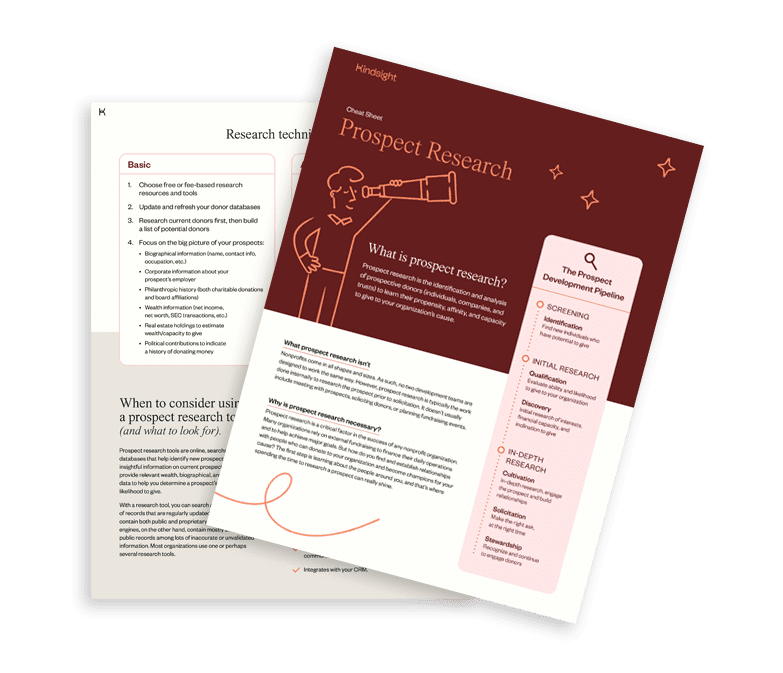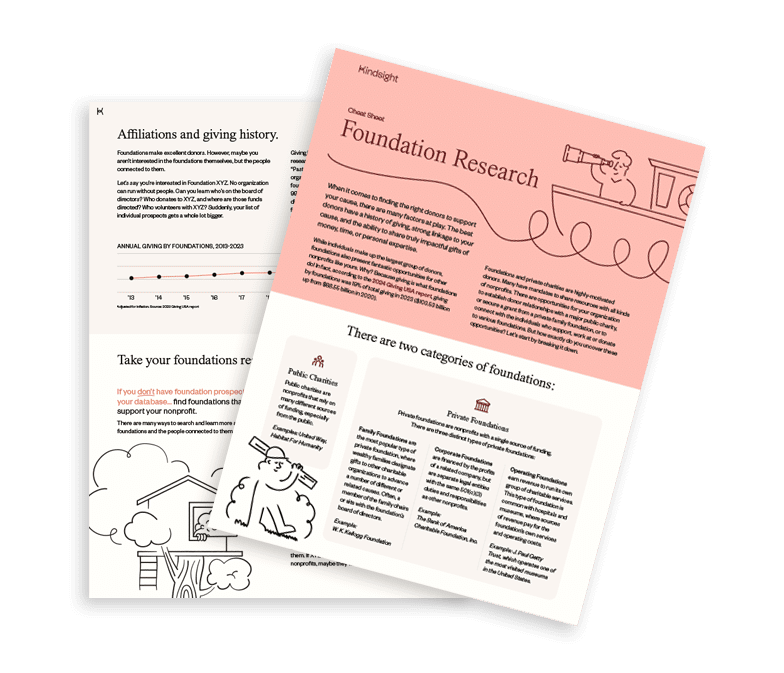
Prospect research plays a pivotal role in the success of nonprofit organizations. It helps identify, analyze, and prioritize potential donors by delving into their backgrounds, philanthropic interests, and capacity to give. This process allows nonprofits to focus their resources and efforts on the most promising supporters, thus increasing the likelihood of securing vital funding.
Furthermore, prospect research enables organizations to create tailored cultivation and solicitation strategies that are based on human connection and resonate with their target audience. By understanding the unique interests and giving patterns of potential donors with comprehensive data, nonprofits can establish meaningful connections that foster long-term support and commitment.
In this comprehensive guide, we will explore the various aspects of prospect research, including strategies and prospect research tools that can help your nonprofit organization thrive in today’s competitive fundraising landscape.
Whether you are new to the world of prospect research or a seasoned professional, this guide will provide valuable insights and practical tips to take your organization’s fundraising efforts to new heights.
What is prospect research?
Prospect research is the process of identifying target donor audiences, analyzing their giving capacity and relevance to the organization’s goals, and prioritizing according to the most suited prospects. It is often also referred to as donor research or donor prospecting.
In order to maximize fundraising efforts, most nonprofit organizations focus on individuals, foundations, or corporations that have a high likelihood of supporting the organization’s mission and vision.
Data-driven approaches allow nonprofit organizations to make informed decisions about who to approach for donations and how to cultivate and maintain long-lasting relationships with their prospective donors.
Understanding your donors is more important than ever.
Our Prospect Research Cheat Sheet equips you with the tools to identify, understand, and engage potential donors effectively.

Who uses prospect research?
Prospect research can be performed by any fundraising organization. Some of the most common organizations that may use this type of research include:
- Universities: Universities identify potential donors who can financially support scholarships, research projects, and campus improvements or upgrades. Prospect research provides a way to build relationships with individuals and foundations interested in supporting education.
- Hospitals: Hospitals find individuals or organizations that can contribute funds for medical equipment, research initiatives, and patient care. Prospect research helps to connect the organization to donors who are passionate about healthcare.
- Human services organizations: Human services organizations and community foundations can find donors via prospect research to help them fund meals, accommodation, tutoring, training programs, and the building or improvement of facilities (such as soup kitchens, homeless shelters, community centers, and recreation centers).
- Social and academic groups in higher education: Social or academic groups in higher education (such assororities and fraternities) can use prospect research to find donors to support leadership development programs, scholarship programs, and community service projects. Prospect research helps in engagement with alumni and individuals who value “Greek” life.
- Museums: Museums use prospect research to fund exhibitions, educational programs, and preservation efforts. It helps in establishing relationships with individuals who are enthusiastic about the arts.
- Theaters: Prospect research provides theaters with the ability to finance productions, outreach programs, and facility upgrades. It aids in connecting these organizations with individuals who have an affinity for the arts.
- Religious organizations: Prospect research provides religious organizations with a means to sustain community programs, facilities, and missionary work. It facilitates engagement with those who share the same religious values.
- Lobbyists: Lobbyists conduct prospect research to identify people who can assist in mobilizing resources for influencing policy decisions and advocating for specific causes. It allows organizations to build relationships with donors who are interested in the causes they aim to influence.
- Activists: Activists conduct prospect research to identify passionate donors who will help with gathering funding for campaigns, awareness initiatives, and social change efforts. It provides a way to build relationships with people who share their goals and mission values.
- Environmental groups: Environmental groups conduct prospect research to find people to drive conservation projects, research, and advocacy for environmental protection. It helps with building and maintaining solid relationships with those who are interested in supporting the environment.
While the above organizations commonly use prospect research, nonprofits of all types can do it!
It’s important to keep in mind that no two organizations are the same and therefore no two prospects will be identical. Ideal major gift donors will vary from nonprofit to nonprofit, so it’s essential you customize your prospect research to match your specific needs as well as your individual cause.
Approaches to prospect research
There are three main approaches to conducting prospect research: designating in-house researchers, hiring external consultants, and investing in fundraising intelligence software.
In-house researchers
Nonprofit teams taking a do-it-yourself approach will enjoy conducting prospect research in-house. In-house prospect research teams typically include a manager/director, researcher/analyst, data analyst, relationship manager/development officer, and prospect research coordinator.
Your staff will scan through documents to analyze an array of factors and build a list of who in your community would make an ideal donor. This is especially helpful if you plan on fundraising solely in your local community.
- The Pros: Conducting prospect research in-house uses staff resources and is ideal for smaller budgets.
- The Cons: Prospect research can be very time-consuming for in-house staff and it can be difficult to find verified results.
When you should use in-house researchers: In-house researchers can be valuable for organizations of all sizes. We’d recommend them for almost any team.
Prospect research consultants
External prospect research consultants and prospect screening companies work in the same fashion as an in-house team in terms of performing wealth screenings; however, they are experts who are not affiliated with your organization. This option can be helpful if your team lacks the time to perform wealth screenings themselves but has the budget for consulting.
- The Pros: Hiring a prospect research consultant saves time and can uncover more prospects.
- The Cons: Hiring a prospect research consultant is costly and doesn’t involve members of your own team.
When you should hire an external prospect research consultant: You should work with a prospect research consultant if you have the finances but are internally strapped for time.
Prospect research software
Online prospect research tools makes the process more efficient for nonprofits of all sizes. Purpose-built donor prospect research software is especially helpful. It analyzes data quickly, helping you find your hidden gems and expand your donor search outside of your immediate community.
If you’re using fundraising intelligence software, you’ll know how much you should be asking each donor for—making your solicitation process more successful and ensuring you don’t leave money on the table. Some of these platforms are customizable, too. You can adjust the parameters to fit your organization’s mission and needs.
- The Pros: Using prospect research software saves time and helps you find unlikely prospects.
- The Cons: Prospect research software requires a budget.
When you should use prospect research software: You should use prospect research software if your nonprofit needs to quickly find new donors on an ongoing basis.
Prospect research process
It is important to follow prospect management best practices. The prospect research process can be divided into the following four steps.
1. Prospect identification
Create a list of potential donors or prospects. This can be achieved by analyzing existing donor databases, using social media platforms, or obtaining referrals from existing supporters.
Analyze your database
Analyzing your database is critical for nonprofits to gain insights into their constituents. Examining donor information such as giving history, frequency, and gift amounts will help identify patterns and trends to form your fundraising strategies. Data analysis can uncover hidden gems as well as identify major gift prospects. You can utilize external donor databases to find appropriate prospects much faster than you would by relying on your existing networks.
Use social media to find donors
Social media allows nonprofits to connect with potential donors and raise awareness of their cause. Leveraging platforms like LinkedIn, Facebook, and Instagram enables organizations to reach a broader audience and engage with prospects who share an affinity for their mission.
Consider creating and using targeted advertising campaigns to reach specific demographics. Create compelling content, share success stories, and educate followers on your organization’s impact.
Referrals from existing donors
Your donors have already proven their love to you. Obtaining referrals from these donors is a powerful way to expand your network and acquire new supporters. When approaching your existing donors for referrals:
- Communicate how crucial their impact on the organization has been.
- Make them aware of ongoing and upcoming projects and successes.
- Provide easy-to-use solutions like personalized referral links, cards, or QR codes.
- Be sure to thank them promptly for their referrals!
2. Research
Once potential prospects are identified, the research phase involves gathering relevant information about each prospect. This includes:
- Personal details such as age, profession, and education
- Philanthropic interests and past giving history
- Financial capacity to give, which can be determined by analyzing wealth indicators like real estate holdings, stock ownership, and business affiliations
If you use a fundraising intelligence tool, all of these details will already be at your disposal, saving a significant amount of time compared to conducting multiple searches for each prospective donor.
If researching prospective donors manually:
Finding a donor’s personal details
- Search for your prospective donors online: Start by searching for your prospects’ activities online. Search for social media profiles, personal websites, networking sites like LinkedIn, or any other platforms where they may share information. These sources can provide insights into their age, profession, and education.
- Visit each prospective donor’s company website: If you’ve identified that your prospect is affiliated with an organization, visit the company website to gather more intel about their current position and professional background.
Finding a donor’s philanthropic interests and past giving history
- Check donor databases: Use donor databases to find information about a prospect’s past charitable donations. These databases house data on philanthropic activities and grants made by individuals and foundations.
- Read publications and reports: Read nonprofit publications, news articles related to philanthropy, and annual reports. They often mention notable donors and their contribution history.
How to determine a donor’s capacity to give
- Browse public records: Analyze public records related to real estate holdings, such as property value and ownership. You can generally find these records through local government websites or county assessor officers.
- Check SEC Filings: If your prospects are involved in publicly traded companies, access the SEC’s EDGAR database to search for filings that can reveal financial information, including stock ownership.
- Identify connections: Look into your prospects’ professional and business connections. This information can be found through company websites and business directories.
Important: You must respect privacy and ethical guidelines while gathering personal information about donors. Ensure you’re receiving the data from legitimate and publicly available sources. Using fundraising intelligence software is the fastest and safest way to access large volumes of up-to-date publicly available information.
3. Analysis
Analyze the donor data gathered in the research stage to evaluate each prospect’s propensity, affinity, and capacity to give. This analysis helps in prioritizing prospects based on their potential value to the organization.
Propensity
Understanding a prospect’s giving history (or propensity) offers valuable insights into their tendency to donate. By examining how individuals have contributed in the past, we can identify philanthropic patterns. For instance:
- Donor A may consistently make small donations at regular intervals.
- Donor B may contribute a significant gift once a year.
- Donor C may contribute their time as a volunteer, board member, or pro bono consultant.
There is no universally perfect donor. However, different nonprofits may consider certain types of donors as ideal matches for their mission.
Affinity
The likelihood that someone will give a significant gift depends heavily on their connection with your organization, or affinity for your cause.
Many times your best prospects are likely in your database already. These donors also have an established history with your organization. This makes it easier to evaluate your relationship with these donors and identify new opportunities to develop these relationships further.
Other times the person may have a history of routinely supporting a similar nonprofit or display a vested interest in your cause. They may work with other nonprofits as a board member or trustee. These are key philanthropic markers (or philanthropic indicators) that may indicate a viable prospect for your nonprofit organization.
Capacity to give
Capacity ratings represent the total amount the prospect can give to all causes over five years. To be clear, this rating or range does not include propensity or affinity. The good news: Capacity ratings are helpful for a gift officer asking for a gift. The bad news: There is no one-size-fits-all formula for determining capacity to give.
Some common wealth markers indicating a large capacity to give include:
- Real estate ownership: Real estate searches tell you a lot about someone’s giving capacity. How many homes do they own? Are their homes free and clear? Are they a real estate investor?
- Stock holdings: What stocks have they invested in? How much of their finances are tied up in the stock market?
- Business affiliations: Who does their company associate with? What perks come from their business’s status? Does their employer offer a matching program?
- Net worth: What is the value of their assets (real estate, personal property, investments) minus their liabilities (mortgages, debts)?
- Income: Do they have more disposable income? Are they more likely to make substantial donations?
It’s important to note that wealth indicators shouldn’t be the lone determining factor in prospect research. A thorough prospect research process that considers other philanthropic markers and individual interests should be used to gather an understanding of each prospective donor’s potential.
Donor analysis examples
Let’s walk through a few examples of prospective donor analysis.
- Donor A—potential as a consultant for your nonprofit: While inactive in terms of financial support, he frequently attends fundraisers and is the husband of a board member. Engage him personally to explore if he can leverage his expertise as a retired consultant to provide valuable advice or support in non-monetary ways. His insights, as well as his network, could be beneficial for your organization’s growth.
- Donor B—potential for a more significant gift toward your capital works: Donates small amounts frequently to your sports programs because she’s an alumni and former soccer star. She operates a successful physiotherapy practice (indicating her growing capacity to contribute more significantly). With your school’s need for a new soccer facility and rehabilitation center, it’s an excellent opportunity to approach her for a more significant donation!
- Donor C—potential inspiration for new donors and volunteers: Despite needing more finances for a significant gift, Donor C’s long-standing involvement as a volunteer presents a valuable opportunity. Recognize and appreciate his commitment by involving him in volunteer leadership or advisory councils. Leverage his advocacy and connections to expand your support network to engage potential donors. By showcasing Donor C’s commitment, you can inspire others to contribute.
4. Strategy
Based on the analysis, a tailored cultivation and solicitation strategy is developed for each prioritized prospect. This includes determining the most suitable communication channels, crafting personalized messages, and designing unique engagement opportunities that resonate with the prospect’s interests and preferences.
Cultivation and solicitation strategies are crucial to the success of your nonprofit because they enable your team to build trust, maximize giving potential, customize communications channels, craft personalized messages, and enhance engagement opportunities. Research underscores the importance of trust in the partnership between nonprofit organizations and their supporters.
Fundraisers significantly increase the likelihood of securing meaningful contributions as well as fostering long-term relationships with constituents by using a targeted, personal approach. Meet your donors where they’re at and consider their communications preferences.
Don’t know how they want to be communicated to? Reach out and ask! Surveys provide a great way of discovering your donors’ preferences!
Interested in foundation research?
Giving by foundations grew 2.4%, to an estimated $109.81 billion in 2024. Get our guide to learn how to research and connect with these highly motivated donors.

Benefits of prospect research
The primary benefits of prospect research include the following:
Saves time and resources
Prospect research saves time and resources for both large and small organizations (and all nonprofits in between). If you can launch a fundraising effort already knowing the best donors to speak to, you’re more likely to achieve success.
Our live profile feature saves even more time, monitoring donor profiles continuously and delivering real-time updates that direct your team to the most suitable potential donors at any given time. This eliminates the need to monitor donor profiles manually, so you can spend more time in the field enacting change and less time trying to find support.
Uncover a major gift donor within your pre-existing donor pool
It’s important to search within your already established donors to learn if any of them could be potential major donors. You already know these donors have the inclination to support your cause, so live profiles will let you know if they have the capability to give more. For large organizations with a vast donor pool, this is a huge time-saver.
Find prospects for key fundraising programs
Prospect research is an effective way to find potential top donors for the following fundraising programs and types:
- Major gifts: Prospect research helps you find donors with the capacity for major gifts and an affinity for your cause.
- Capital campaigns: There are times when you may launch major fundraising events such as a capital campaign to build a new structure or to acquire top-of-the-line medical equipment.
- Planned giving programs: Your organization might want to launch a planned giving program to benefit from significant gifts upon the passing of loyal donors.
- Grateful patient programs: Grateful patient programs give past beneficiaries of healthcare institutions the opportunity to become donors themselves.
Identify new prospects
As your organization grows, you’ll need more funds and therefore more donors. By performing regular prospect research, you’ll be able to uncover more donors to continue propelling your mission forward.
Study donor giving patterns
Use prospect research to study up on your current donors to better learn about the future of their charitable behavior. By studying their patterns, you may be able to determine what time of year they are more charitable so that you can ask for a major gift donation during that time.
Prospect research misconceptions
The following are some common misconceptions you might come across in online resources that would complicate the prospect research process in some way.
- Prospect research is not a one-time process. Prospect research should be ongoing. The philanthropic landscape is ever-changing. Individuals’ wealth, priorities, and interests also change over time. Prospect research isn’t just about identifying potential donors, it’s also about discovering new opportunities. You can do this by conducting ongoing prospect research.
- Prospect research is not wealth screening. Wealth screening is one part of the entire prospect research process. Prospect research goes beyond wealth screening, allowing you to uncover a variety of factors that help organizations gain a better understanding of their prospects. Some key aspects of prospect research include:
- Affinity, capacity, and propensity
- Personal and professional networks
- Demographics and psychographics
- Data analysis and predictive modeling
- Prospect research is not just “research”. Prospect research involves a multifaceted process that goes beyond just gathering information. It involves strategic decision-making, relationship-building, and proactive engagement. Prospect research also provides insights into how to continuously improve your approach.
- Not everyone can do “prospect research”. You need a dedicated team! Prospect research requires specialized skills and expertise. Teams need to be able to understand complex data, wealth indicators, and philanthropic interests.
Find donors faster with effective prospect research
Prospect research is a vital and ongoing part of nonprofit fundraising. Finding donors with a propensity to give, an affinity for your cause, and the capacity to give a significant amount gives your nonprofit the peace of mind that you have a solid foundation for your annual costs, a specific project, or a capital campaign before reaching out to the public.
The prospect research process requires a dedicated team, consultant, or staff member supported by fundraising intelligence software to identify prospects, research them, analyze the data collected, and develop a personalized strategy for each prospective donor. Having the right prospect research tools makes the whole process significantly more efficient and effective—helping you secure vital funds faster so you can focus on advancing your mission.
Further reading:
Due Diligence in Prospect Research
How to Capitalize on Prospect Screening Results
Here’s Why Your Screening Solution Is Missing 80% of Donors
Be the first to read our resources.
The world is changing quickly—and our resources help you stay on top of it all. Sign up to get new insights, success stories, and more, sent right to your inbox.




